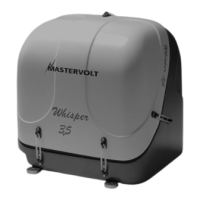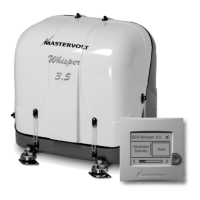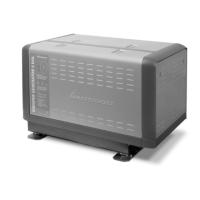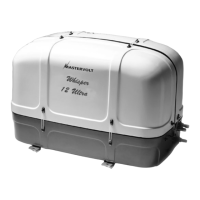22 April 2004 / WHISPER 3,5 / USA
5 TROUBLE SHOOTING
5.1 ALTERNATOR/ ELECTRICAL FAULTS
Beware of parts which are live!
Remove 3 Amp. fuse in the control panel
while working on the generator to prevent
the engine to start.
5.1.1 General
If any problem should occur check basic conditions and
examine all external wiring, switch gear and circuit
breakers. Also check if measuring instruments give the
correct value.
If in doubt measure directly on the alternator terminals
with an independent instrument.
This should only be carried out by an experienced electri-
cian.
Check if the engine is running correctly at 3600 (60 Hz)
RPM according to its settings and does as well under
load. A RPM drop of 5% at full load is acceptable. There-
fore a no load setting should be at 3750 RPM = 62.5 Hz.
Under no circumstances should the RPM under full load
be below 3540 = 59 Hz.
When the problem is in the RPM refer to the engine fault
finding paragraph.
Digital Diesel Control systemwill help to indicate failures
and display causes.
5.1.2 Trouble shooting table
PROBLEM CAUSE SOLUTION
No output (Voltage) at all. • Circuit breaker "off" or faulty fuse Check switches and fuses and measure direct-
ly on the alternator to exclude external causes.
• Low engine RPM. Check the engine RPM and adjust (refer to
special procedures).
• Loss of residual magnetism. Check the residual magnetism and flash the
alternator (refer to special procedures).
• Capacitor loose or broken. Check by independent excitation if the problem is
in the capacitor or in the windings.
• Rotor diodes broken. Check the diodes in the rotor (refer to special
procedures) The Whisper 3,5 has two diodes in
the rotor. It happens very rarely that both are
broken. When only one diode is broken the
voltage will be low but will not varnish completely.
Generator output voltage too • No load at all or very low load. Switch on a load and check voltage.
low when no load is on it • Engine is not reaching the rated RPM. Refer to special procedures to readjust RPM.
(less than 105V). • Defective capacitor. Check capacitor and replace if necessary (refer
to special procedures).
• Defective diode (one of the two) Check the diodes in the rotor and replace (refer to
special procedures).
Generator output voltage too • Generator is overloaded. Switch off a load; (part off ) consumers.
low under load (less than 105V). • Engine is not reaching the rated RPM. Refer to engine RPM problems.
In no load condition it is ok. • Defective capacitor. Check capacitor and replace if necessary (refer
to special procedures).
Generator voltage too high, • Engine is running too fast (RPM too high). Check engine speed and adjust (refer to special
(more than 130V). procedures).
• Over-energising due to defective Check capacitor specification and replace if
capacitors. necessary.
• Presence of a strong capacative load Compensate for this capacity and seek for experts
(leading power factor). advice.
Generator voltage fluctuates. • Disturbances on the electrical system/ Check if electrical load is fluctuating.
user side.
• Engine runs irregularly. When engine runs irregularly refer to section:
"Engine runs irregularly".
TROUBLE SHOOTING

